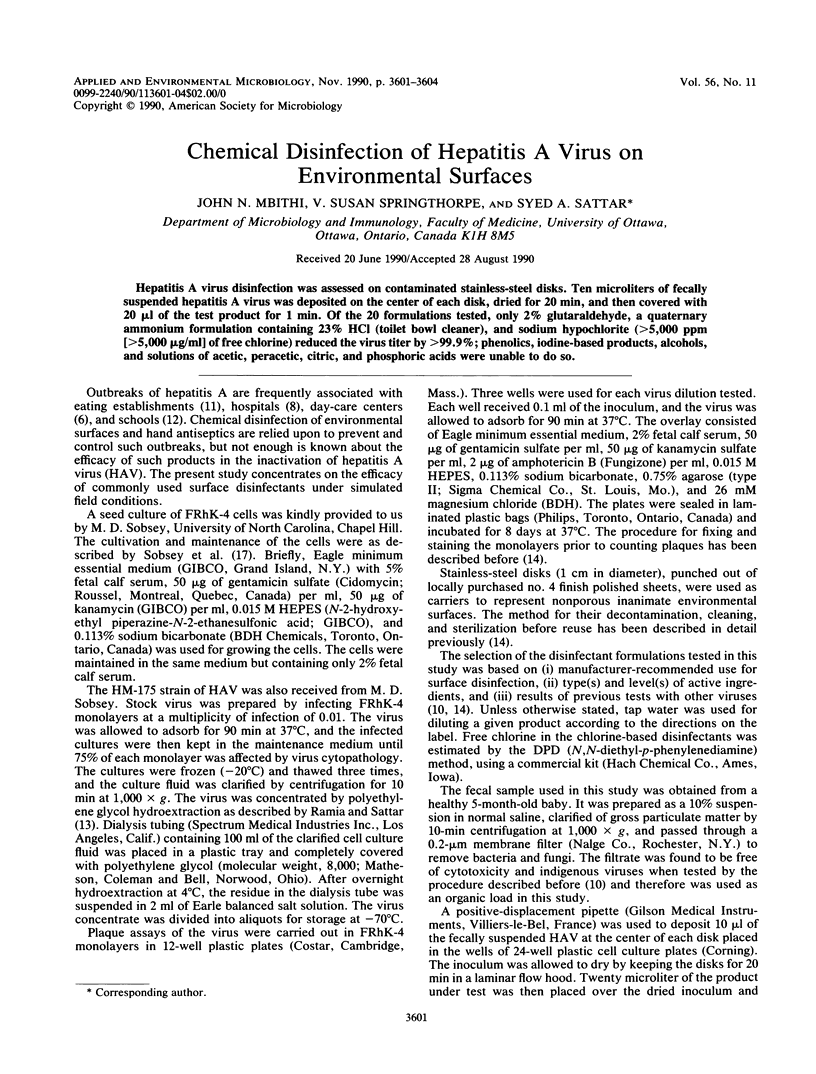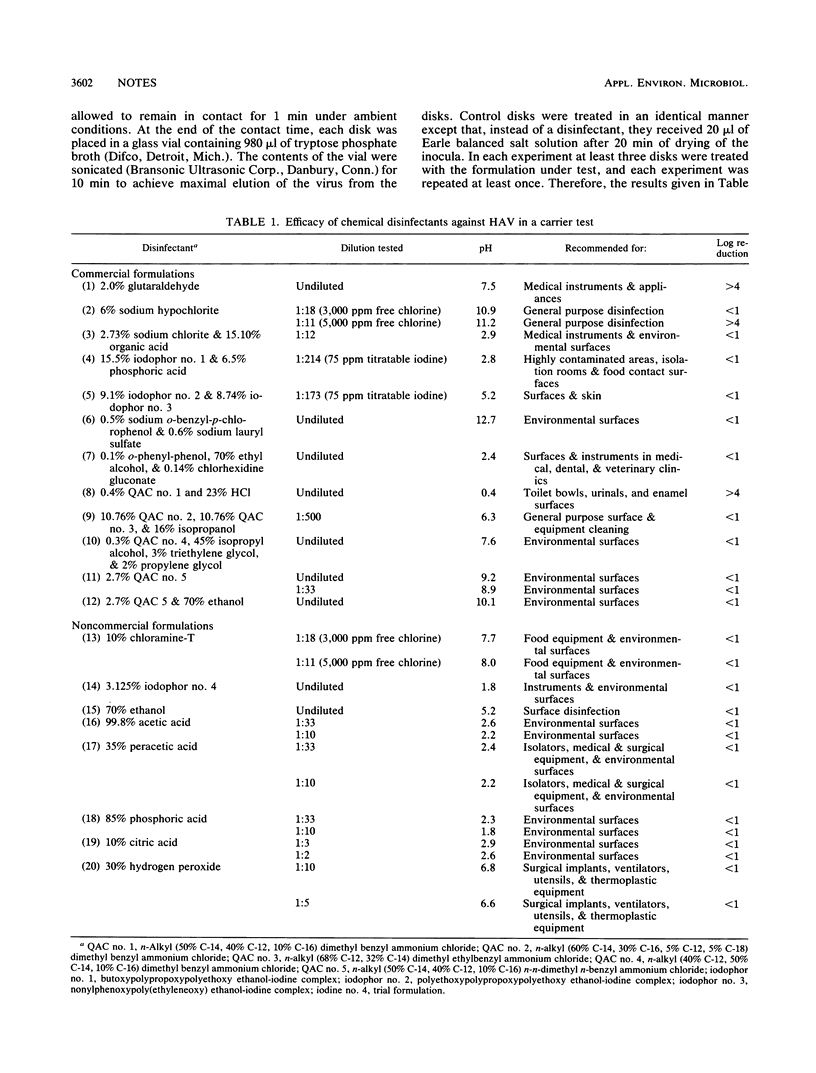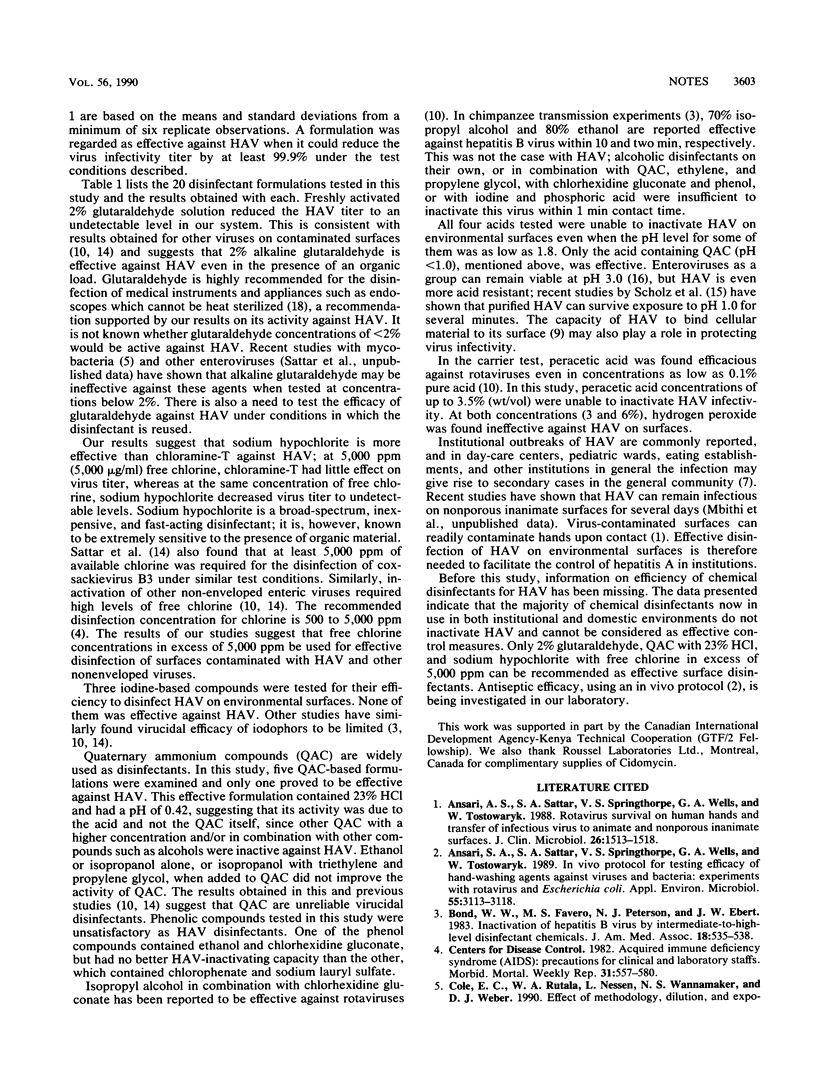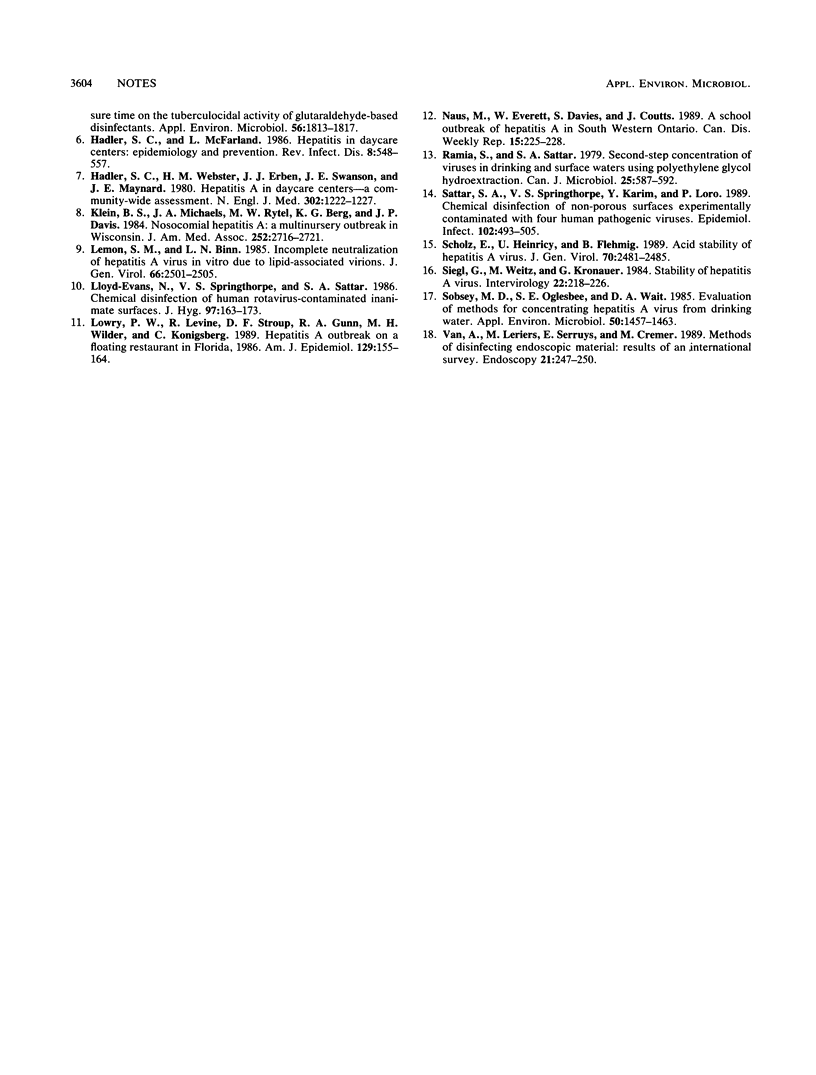Abstract
Hepatitis A virus disinfection was assessed on contaminated stainless-steel disks. Ten microliters of fecally suspended hepatitis A virus was deposited on the center of each disk, dried for 20 min, and then covered with 20 microliters of the test product for 1 min. Of the 20 formulations tested, only 2% glutaraldehyde, a quaternary ammonium formulation containing 23% HCl (toilet bowl cleaner), and sodium hypochlorite (greater than 5,000 ppm [greater than 5,000 micrograms/ml] of free chlorine) reduced the virus titer by greater than 99.9%; phenolics, iodine-based products, alcohols, and solutions of acetic, peracetic, citric, and phosphoric acids were unable to do so.
Full text
PDF



Selected References
These references are in PubMed. This may not be the complete list of references from this article.
- Ansari S. A., Sattar S. A., Springthorpe V. S., Wells G. A., Tostowaryk W. In vivo protocol for testing efficacy of hand-washing agents against viruses and bacteria: experiments with rotavirus and Escherichia coli. Appl Environ Microbiol. 1989 Dec;55(12):3113–3118. doi: 10.1128/aem.55.12.3113-3118.1989. [DOI] [PMC free article] [PubMed] [Google Scholar]
- Ansari S. A., Sattar S. A., Springthorpe V. S., Wells G. A., Tostowaryk W. Rotavirus survival on human hands and transfer of infectious virus to animate and nonporous inanimate surfaces. J Clin Microbiol. 1988 Aug;26(8):1513–1518. doi: 10.1128/jcm.26.8.1513-1518.1988. [DOI] [PMC free article] [PubMed] [Google Scholar]
- Bond W. W., Favero M. S., Petersen N. J., Ebert J. W. Inactivation of hepatitis B virus by intermediate-to-high-level disinfectant chemicals. J Clin Microbiol. 1983 Sep;18(3):535–538. doi: 10.1128/jcm.18.3.535-538.1983. [DOI] [PMC free article] [PubMed] [Google Scholar]
- Hadler S. C., McFarland L. Hepatitis in day care centers: epidemiology and prevention. Rev Infect Dis. 1986 Jul-Aug;8(4):548–557. doi: 10.1093/clinids/8.4.548. [DOI] [PubMed] [Google Scholar]
- Hadler S. C., Webster H. M., Erben J. J., Swanson J. E., Maynard J. E. Hepatitis A in day-care centers. A community-wide assessment. N Engl J Med. 1980 May 29;302(22):1222–1227. doi: 10.1056/NEJM198005293022203. [DOI] [PubMed] [Google Scholar]
- Klein B. S., Michaels J. A., Rytel M. W., Berg K. G., Davis J. P. Nosocomial hepatitis A. A multinursery outbreak in Wisconsin. JAMA. 1984 Nov 16;252(19):2716–2721. doi: 10.1001/jama.252.19.2716. [DOI] [PubMed] [Google Scholar]
- Lemon S. M., Binn L. N. Incomplete neutralization of hepatitis A virus in vitro due to lipid-associated virions. J Gen Virol. 1985 Nov;66(Pt 11):2501–2505. doi: 10.1099/0022-1317-66-11-2501. [DOI] [PubMed] [Google Scholar]
- Lloyd-Evans N., Springthorpe V. S., Sattar S. A. Chemical disinfection of human rotavirus-contaminated inanimate surfaces. J Hyg (Lond) 1986 Aug;97(1):163–173. doi: 10.1017/s0022172400064445. [DOI] [PMC free article] [PubMed] [Google Scholar]
- Lowry P. W., Levine R., Stroup D. F., Gunn R. A., Wilder M. H., Konigsberg C., Jr Hepatitis A outbreak on a floating restaurant in Florida, 1986. Am J Epidemiol. 1989 Jan;129(1):155–164. doi: 10.1093/oxfordjournals.aje.a115104. [DOI] [PubMed] [Google Scholar]
- Naus M., Everett W., Davies S., Coutts J. A school outbreak of hepatitis A in southwestern Ontario. Can Dis Wkly Rep. 1989 Nov 11;15(45):225–228. [PubMed] [Google Scholar]
- Ramia S., Sattar S. A. Second-step concentration of viruses in drinking and surface waters using polyethylene glycol hydroextraction. Can J Microbiol. 1979 May;25(5):587–592. doi: 10.1139/m79-084. [DOI] [PubMed] [Google Scholar]
- Sattar S. A., Springthorpe V. S., Karim Y., Loro P. Chemical disinfection of non-porous inanimate surfaces experimentally contaminated with four human pathogenic viruses. Epidemiol Infect. 1989 Jun;102(3):493–505. doi: 10.1017/s0950268800030211. [DOI] [PMC free article] [PubMed] [Google Scholar]
- Scholz E., Heinricy U., Flehmig B. Acid stability of hepatitis A virus. J Gen Virol. 1989 Sep;70(Pt 9):2481–2485. doi: 10.1099/0022-1317-70-9-2481. [DOI] [PubMed] [Google Scholar]
- Siegl G., Weitz M., Kronauer G. Stability of hepatitis A virus. Intervirology. 1984;22(4):218–226. doi: 10.1159/000149554. [DOI] [PubMed] [Google Scholar]
- Sobsey M. D., Oglesbee S. E., Wait D. A. Evaluation of methods for concentrating hepatitis A virus from drinking water. Appl Environ Microbiol. 1985 Dec;50(6):1457–1463. doi: 10.1128/aem.50.6.1457-1463.1985. [DOI] [PMC free article] [PubMed] [Google Scholar]
- Van Gossum A., Loriers M., Serruys E., Cremer M. Methods of disinfecting endoscopic material: results of an international survey. Endoscopy. 1989 Nov;21(6):247–250. doi: 10.1055/s-2007-1012962. [DOI] [PubMed] [Google Scholar]


